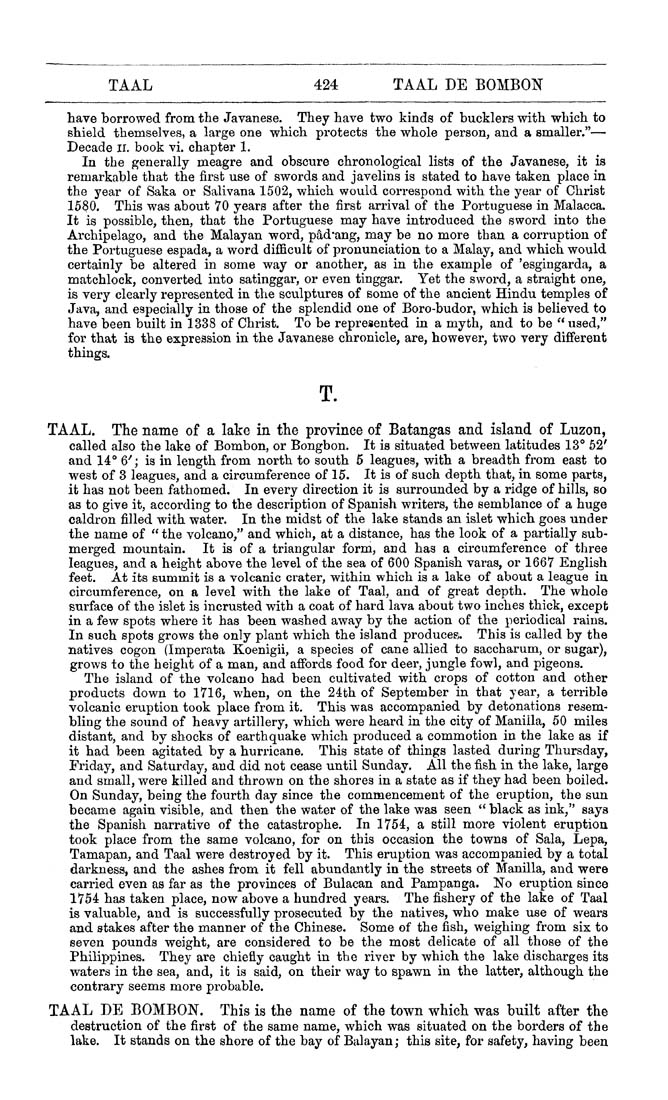TAAL 424 TAAL DE BOMBON
have borrowed from the Javanese. They have two kinds of bucklers with which to
shield themselves, a large one which protects the whole person, and a smaller."—
Decade ii. book vi. chapter 1.
In the generally meagre and obscure chronological lists of the Javanese, it is
remarkable that the first use of swords and javelins is stated to have taken place in
the year of Saka or Salivana 1502, which would correspond with the year of Christ
1580. This was about 70 years after the first arrival of the Portuguese in Malacca.
It is possible, then, that the Portuguese may have introduced the sword into the
Archipelago, and the Malayan word, pS,d*ang, may be no more than a corruption of
the Portuguese espada, a word diflacult of pronunciation to a Malay, and which would
certainly be altered in some way or another, as in the example of 'esgingarda, a
matchlock, converted into satinggar, or even tinggar. Yet the sword, a straight one,
is very clearly represented in the sculptures of some of the ancient Hindu temples of
Java, and especially in those of the splendid one of Boro-budor, which is believed to
have been built in 1338 of Christ. To be represented in a myth, and to be " used,"
for that is the expression in the Javanese chronicle, are, however, two very different
things.
T.
TAAL. The name of a lake in the province of Batangas and island of Luzon,
called also the lake of Bombon, or Bongbon. It is situated between latitudes 13° 52'
and 14° 6'; is in length from north to south 5 leagues, with a breadth from east to
west of 3 leagues, and a circumference of 15. It is of such depth that, in some parts,
it has not been fathomed. In every direction it is surrounded by a ridge of hills, so
as to give it, according to the description of Spanish writers, the semblance of a huge
caldron filled with water. In the midst of the lake stands an islet which goes under
the name of " the volcano," and which, at a distance, has the look of a partially sub¬
merged mountain. It is of a triangular form, and has a circumference of three
leagues, and a height above the level of the sea of 600 Spanish varas, or 1667 English
feet. At its summit is a volcanic crater, within which is a lake of about a league in
circumference, on a level with the lake of Taal, and of great depth. The whole
surface of the islet is incrusted with a coat of hard lava about two inches thick, except
in a few spots where it has beeu washed away by the action of the periodical rains.
In such spots grows the only plant which the island produces. This is called by the
natives cogon (Imperata Koenigii, a species of cane allied to saccharum, or sugar),
grows to the height of a man, and affords food for deer, jungle fowl, and pigeons.
The island of the volcano had been cultivated with crops of cotton and other
products down to 1716, when, on the 24th of September in that year, a terrible
volcanic eruption took place from it. This was accompanied by detonations resem¬
bling the sound of heavy artillery, which were heard in the city of Manilla, 50 miles
distant, and by shocks of earthquake which produced a commotion in the lake as if
it had been agitated by a hurricane. This state of things lasted during Thursday,
Friday, and Saturday, and did not cease until Sunday. All the fish in the lake, large
and small, were killed and thrown on the shores in a state as if they had been boiled.
On Sunday, being the fourth day since the commencement of the eruption, the sun
became again visible, and then the water of the lake was seen " black as ink," says
the Spanish narrative of the catastrophe. In 1754, a still more violent eruption
took place from the same volcano, for on this occasion the towns of Sala, Lepa,
Tamapan, and Taal were destroyed by it. This eruption was accompanied by a total
darkness, and the ashes from it fell abundantly in the streets of Manilla, and were
carried even as far as the provinces of Bulacan and Pampanga. No eruption since
1754 has taken place, now above a hundred years. The fishery of the lake of Taal
is valuable, and is successfully prosecuted by the natives, who make use of wears
and stakes after the manner of the Chinese. Some of the fish, weighing from six to
seven pounds weight, are considered to be the most delicate of all those of the
Philippines. They are chiefly caught in the river by which the lake discharges its
waters in the sea, and, it is said, on their way to spawn in the latter, although the
contrary seems more probable.
TAAL DE BOMBON. This is the name of the town which was built after the
destruction of the first of the same name, which was situated on the borders of the
lake. It stands on the shore of the bay of Balayan; this site, for safety, having been
|








